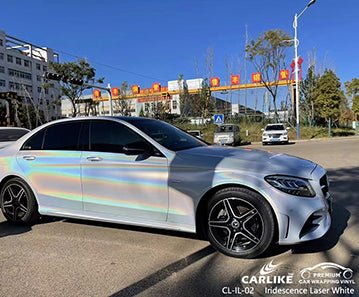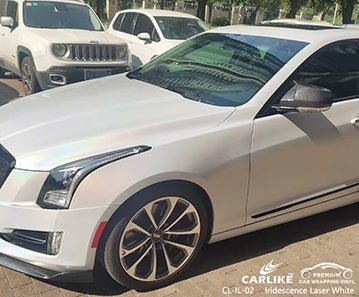Understanding Car Wraps: Types, Materials, and Applications
Understanding Car Wraps: Types, Materials, and Applications is a crucial topic when it comes to exploring the world of vehicle aesthetics and customization. In this comprehensive explanation, we will delve into the various aspects of car wraps, including their types, materials used, and their applications in the automotive industry.
Car wraps are a popular way to transform the appearance of a vehicle. They are large vinyl sheets that are specifically designed to cover the exterior surface of cars, providing a wide range of color, texture, and design options. Unlike traditional paint jobs, car wraps are temporary and can be easily removed without causing damage to the underlying paint.
When it comes to types of car wraps, there are primarily two categories: partial wraps and full wraps. Partial wraps involve applying the vinyl material to specific areas of the car, such as the hood, roof, or side panels, while leaving other parts exposed. On the other hand, full wraps encompass covering the entire surface of the vehicle with the vinyl material, completely transforming its appearance.

Now, let's discuss the materials used in car wraps. The most common material is cast vinyl, which is highly durable and conformable to the shape of the vehicle. Cast vinyl offers excellent resistance to UV rays, weather conditions, and wear and tear, ensuring the longevity of the wrap. Another material used is calendared vinyl, which is more affordable but less durable and prone to shrinkage over time.
Car wraps have a multitude of applications in the automotive industry. Firstly, they serve as a form of vehicle customization for individual car owners who wish to personalize their rides. Car wraps provide an opportunity to change the color, add patterns, or incorporate unique designs to reflect one's personality or brand. Moreover, wraps can be used for commercial purposes, such as advertising or branding vehicles for businesses. Many companies utilize car wraps as a mobile marketing tool, turning their vehicles into eye-catching advertisements on the road.
Understanding the different types, materials, and applications of car wraps is essential for both car owners and enthusiasts alike. It allows individuals to make informed decisions about whether to invest in a car wrap, which type to choose based on their preferences and needs, and how to properly maintain and remove the wrap when desired.
In conclusion, car wraps provide an exciting avenue for transforming the appearance of vehicles. By understanding the various types, materials, and applications, car owners can explore the world of car customization, express their creativity, and turn their vehicles into unique works of art or effective marketing tools.
Tools and Equipment: Essential Items for a Smooth Wrap Removal
1. Heat Gun or Steamer: A heat gun or steamer is a crucial tool for softening the adhesive underneath the car wrap. By applying heat to the vinyl surface, the adhesive becomes more pliable, making it easier to peel off the wrap without damaging the underlying paint.
2. Plastic Razor Blades or Wrap Removal Tools: Plastic razor blades or specialized wrap removal tools are non-abrasive and designed specifically for removing vinyl wraps. These tools help in gently lifting the edges of the wrap and separating it from the surface of the car, minimizing the risk of scratching or damaging the paint.
3. Isopropyl Alcohol or Adhesive Remover: Isopropyl alcohol or adhesive remover is used to dissolve any residual adhesive that remains on the car after removing the wrap. Applying a small amount of alcohol or adhesive remover on a microfiber cloth helps to break down the adhesive and facilitate its removal without harming the paint.
4. Microfiber Cloths or Soft Towels: Microfiber cloths or soft towels are essential for wiping down the car and removing any adhesive residue or cleaning agents. They are gentle on the paint surface and help maintain its shine and finish.
5. Goo Gone or Citrus-Based Cleaner: Goo Gone or a citrus-based cleaner can be used in conjunction with a microfiber cloth to further assist in removing any stubborn adhesive residue. These cleaners are safe to use on automotive surfaces and effectively dissolve the adhesive without causing damage.

6. Paint Protection Film (PPF) Installation Squeegee: A PPF installation squeegee or a soft, flexible squeegee can aid in the removal process by smoothing out the vinyl wrap during the peeling process. It helps to ensure even pressure distribution, preventing wrinkles or bubbles from forming.
7. Protective Gloves: Protective gloves are crucial during the wrap removal process to protect your hands from any potential injuries, cuts, or chemical exposure. Opt for gloves that provide dexterity and are suitable for handling adhesives and cleaning agents.
8. Ladder or Step Stool: Depending on the size and height of your vehicle, a ladder or step stool may be necessary to reach higher areas during the wrap removal process. Safety is paramount, so choose a stable and secure platform that allows you to work comfortably.
By having these essential tools and equipment readily available, you can ensure a smooth and efficient wrap removal process while minimizing the risk of damaging the car's surface. Remember to follow proper safety precautions and techniques to achieve the best results.
In conclusion, the right tools and equipment are instrumental in achieving a successful wrap removal process. By using a combination of heat guns, plastic razor blades, adhesive removers, microfiber cloths, and other essential items, you can safely and effectively remove the car wrap, leaving behind a clean surface ready for any further customization or restoration.
Preparing Your Car: Steps to Take Before Removing the Wrap
1. Gather the Necessary Tools and Materials: Before you begin the preparation process, gather all the tools and materials you will need for the wrap removal. This includes items such as a heat gun or steamer, plastic razor blades or wrap removal tools, isopropyl alcohol or adhesive remover, microfiber cloths or soft towels, and any other specific tools recommended for your particular type of car wrap.
2. Choose the Right Environment: Selecting the appropriate environment for wrap removal is important. Ideally, perform the removal in a well-ventilated area, such as a garage or outdoor space, to allow for proper air circulation and ventilation. Ensure that the area is clean and free from dust and debris that could interfere with the removal process.
3. Wash the Car: Thoroughly wash the entire vehicle before starting the wrap removal process. This removes any dirt, grime, or contaminants that may have accumulated on the surface, which can affect the adhesive and make it more difficult to remove the wrap. Use a gentle automotive soap and a soft sponge or wash mitt to avoid scratching the paint.
4. Perform a Test Spot: Before diving into the complete wrap removal, it's a good idea to perform a test spot in an inconspicuous area of the car. This allows you to assess the condition of the underlying paint, test the effectiveness of the tools and materials you will be using, and determine the best technique for removing the wrap without causing damage.
5. Ensure Proper Heat Application: Heat is crucial for softening the adhesive and making the wrap easier to remove. Use a heat gun or steamer to apply heat evenly to the surface of the wrap. Be cautious not to overheat the vinyl, as this can damage both the wrap and the underlying paint. Maintain a safe distance and keep the heat source in constant motion.
6. Start from the Edges: Begin the wrap removal process by focusing on the edges of the vinyl. Gently lift the edges using plastic razor blades or wrap removal tools. Work slowly and carefully, ensuring that the adhesive is adequately heated and the wrap is being peeled off evenly. Avoid pulling or tugging forcefully, as this can lead to paint damage.

7. Remove Residual Adhesive: Once the wrap is fully removed, you may encounter residual adhesive left on the surface of the car. Use isopropyl alcohol or an adhesive remover on a microfiber cloth to dissolve and remove the adhesive. Work in small sections, applying the solution and gently rubbing the surface until the adhesive is completely gone.
8. Clean and Inspect: After removing the wrap and adhesive residue, thoroughly clean the surface of the car using mild automotive soap and water. Rinse the surface well to ensure all cleaning agents are removed. Once dry, inspect the paint for any signs of damage or imperfections. If necessary, consider polishing or waxing the paint to restore its shine and finish.
By following these steps to properly prepare your car before removing the wrap, you can minimize the risk of paint damage, ensure a smooth removal process, and achieve a clean surface ready for any further customization or restoration. Take your time, exercise caution, and remember to refer to any specific instructions provided by the wrap manufacturer for the best results.
In conclusion, proper preparation is key to a successful wrap removal process. By gathering the necessary tools, choosing the right environment, washing the car, performing a test spot, applying heat correctly, starting from the edges, removing residual adhesive, and cleaning and inspecting the paint, you can set the stage for a smooth and effective wrap removal, leaving your car's surface in optimal condition.
Step-by-Step Wrap Removal Process: A Detailed Guide
Step 1: Gather the Necessary Tools and Materials
Before starting the wrap removal process, gather all the essential tools and materials. This includes a heat gun or steamer, plastic razor blades or wrap removal tools, isopropyl alcohol or adhesive remover, microfiber cloths or soft towels, and any other specific tools recommended for your particular type of car wrap.
Step 2: Perform a Test Spot
Perform a test spot in an inconspicuous area of the car to assess the condition of the underlying paint and test the effectiveness of the tools and materials. This helps you determine the best technique and ensure that the process won't damage the paint.
Step 3: Apply Heat to the Wrap
Using a heat gun or steamer, apply heat evenly to the surface of the wrap. This softens the adhesive and makes the wrap more pliable for removal. Keep the heat source moving and maintain a safe distance to avoid overheating or damaging the wrap or paint.
Step 4: Start Removing the Wrap from the Edges
Begin by focusing on the edges of the wrap. Gently lift the edges using plastic razor blades or wrap removal tools. Work slowly and carefully, ensuring that the adhesive is adequately heated and the wrap is being peeled off evenly. Avoid pulling or tugging forcefully, as this can cause damage to the paint.
Step 5: Gradually Remove the Wrap
Continue peeling off the wrap gradually, working your way across the surface of the car. Apply heat as needed to soften the adhesive. Use gentle and steady motions, keeping the wrap at a low angle to minimize the risk of tearing or leaving residue behind.
Step 6: Remove Residual Adhesive
After the wrap is fully removed, you may encounter residual adhesive on the car's surface. Apply isopropyl alcohol or adhesive remover to a microfiber cloth and gently rub the affected areas. This helps dissolve and remove the adhesive. Work in small sections until all the residue is gone.
Step 7: Clean the Surface
Thoroughly clean the surface of the car using mild automotive soap and water. Rinse well to ensure all cleaning agents are removed. Dry the surface completely using microfiber cloths or soft towels.
Step 8: Inspect the Paint
Once the surface is clean and dry, inspect the paint for any signs of damage or imperfections. If necessary, consider using a clay bar or polish to further remove any residue or restore the paint's smoothness and shine.
Step 9: Apply Paint Protection or New Wrap (Optional)
If desired, this is an opportune time to apply a paint protection film (PPF) or a new car wrap. Ensure the surface is clean, smooth, and free of any residue before proceeding with the application.
By following this step-by-step guide, you can safely and effectively remove a car wrap. Remember to work slowly, apply heat as needed, and exercise caution to avoid damaging the underlying paint.
FAQ for how to remove wrap from car?
Q: Is it possible to remove a car wrap without damaging the underlying paint?
A: Yes, it is possible to remove a car wrap without damaging the paint if the removal process is done correctly. Proper techniques, tools, and patience are key to minimizing any potential damage.
Q: Do I need any specific tools to remove a car wrap?
A: Yes, some essential tools for wrap removal include a heat gun or steamer, plastic razor blades or wrap removal tools, isopropyl alcohol or adhesive remover, microfiber cloths or soft towels, and possibly a PPF installation squeegee.
Q: How do I soften the adhesive on the car wrap?
A: Apply heat to the wrap using a heat gun or steamer. The heat softens the adhesive, making it easier to peel off. Maintain a safe distance, keep the heat source moving, and avoid overheating the wrap or paint.
Q: Can I use a hairdryer instead of a heat gun?
A: While a hairdryer can provide some heat, it may not be as effective as a heat gun or steamer. Professional-grade tools are recommended for better results, as they provide higher temperatures and airflow.
Q: How do I start removing the car wrap?
A: Begin by lifting the edges of the wrap using plastic razor blades or wrap removal tools. Apply heat as needed and work slowly, peeling off the wrap gradually from the edges.
Final Words
In conclusion, by following this comprehensive wrap removal tutorial, you can uncover your car's true beauty and restore its original appearance. With the right tools, proper preparation, and step-by-step guidance, removing the car wrap becomes a manageable task. Remember to approach the process with patience, taking care to avoid any damage to the underlying paint.
Whether you're preparing for a new wrap, paint protection film, or simply want to enjoy your car's natural aesthetics, this tutorial equips you with the knowledge to achieve a successful wrap removal. Unleash your car's true potential and enjoy the satisfaction of revealing its pristine finish, ready for the next exciting chapter in its automotive journey.









